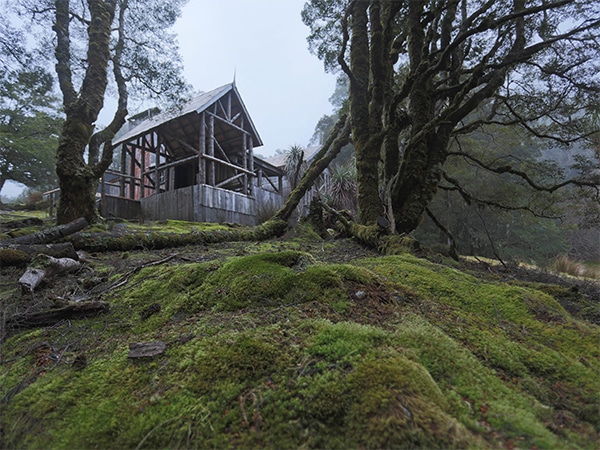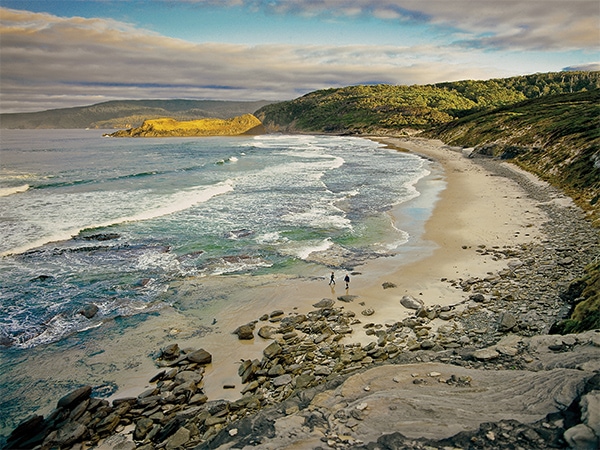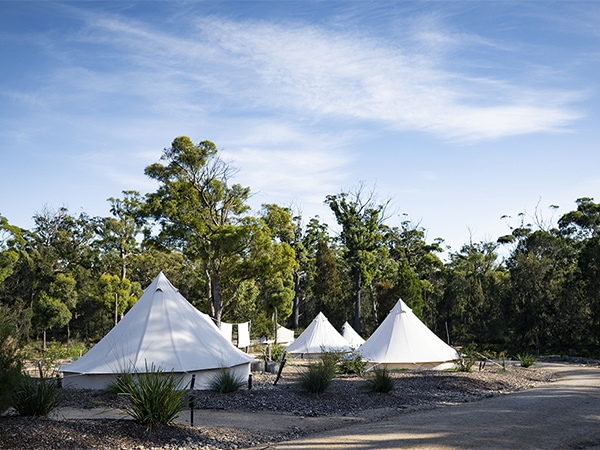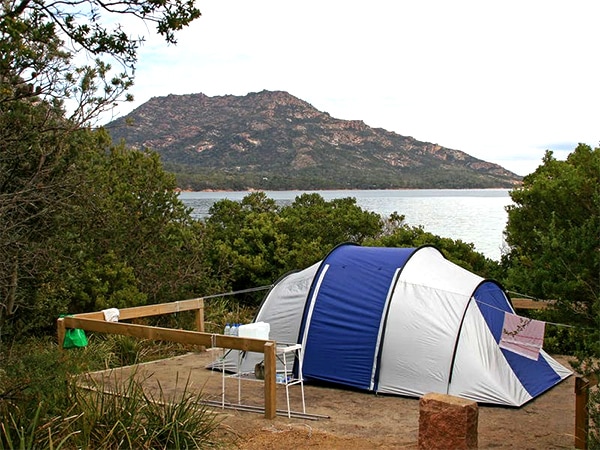30 October 2023
![]() 6 mins Read
6 mins Read

Tasmania boasts some of Australia’s most picturesque places, and nature lovers swarm to get a glimpse of this relatively untouched paradise.
If you’re dreaming of Tassie’s bucket-list worthy wonders, then there’s no better way to explore than by packing your tent and setting up camp at one of these awe-inspiring spaces. Be prepared – much of the camping here is on the rough side (the price you pay for paradise, and why many people decide to hire a campervan) and you may need to bring your own supplies – including water.
If you’re happy to camp by the roadside then you can take advantage of free campsites, but if you fancy a view you’ll need to book ahead of time – especially during peak periods. Lucky for you, we’ve done the heavy lifting so you can start dreaming.
Cradle Mountain is a photographer’s dream. Think sparkling, glacial lakes beneath rugged mountains – some of the most Insta-worthy views you’ll come across in all of Tasmania. The park attracts bushwalkers of all levels, and wildlife lovers will delight in visits from the local devils and quolls. Camping at Cradle Mountain provides your own storyland wilderness adventure, and the best views can be snagged by setting up a tent on the mountain’s peaks.
If you’re walking the famous Overland Track, campsites and huts are located throughout the track, and this is where you’ll find the real gems. If you’re not tempted to trek, but still crave a fairy forest immersion, you can book a cabin at Waldheim, located five kilometres inside the park and equipped with heating, beds, basic cooking utensils and amenities (though it’s not technically camping, it’s almost as humble).
There’s also the privately owned Discovery Park near the park entrance, which, as far as caravan parks go, is nice enough and perfectly places you for majestic daytime adventures. Make sure to include a soak at Waldheim Alpine Spa at Cradle Mountain Lodge – offering beautiful views and a steam room, sauna, plunge pool and spa to soak away the day.

The brooding Waldheim cabin (Photo: Graham Freeman)
Sitting upon the pristine Recherche Bay, on the edge of the wild and untouched Southwest National Park, Cockle Creek boasts tranquil coves and sandy beaches with a snow-capped mountain backdrop – and that’s just the beginning. Add a rich history that’s still visible – including Aboriginal sites, abandoned tramways, gravestones and ruins – and you have yourself a recipe for an incredibly inspiring adventure.
There are plenty of rustic camping options at Recherche Bay Nature Recreation area that take advantage of the abundant nature surrounds (head to Bolton’s Green if you’re looking for a roomy site). Camping is free, but once you’re over the Cockle Creek bridge national park entry fees apply.
The road to the creek is rough in places, so take care (especially if you’re travelling in a camper). If you’re up for it, the five-hour walk to South Cape Bay is well worth the magnificent views of the Great Southern Ocean that greet you. Put together a pack (with plenty of food and water) and make a day of it – you won’t be disappointed.

Cockle creek boasts tranquil waters and sandy beaches (Photo: Geoffrey Lea)
With 50 kilometres of pristine coastline from Binalong Bay (in the south) to Eddystone Point (the bottom of Mt William National Park), you’ll be spoiled for choice at the beautiful Bay of Fires. Hop along bright orange boulders, feel the white sand between your toes and enjoy a (very invigorating!) dip in crystal clear waters. Binalong Bay is a good place to start, and there are campgrounds aplenty along the way, but Bay of Fires Bush Retreat really takes the cake if you’re feeling something extra special.
The perfect base to explore the area, you can choose from a handful of accommodation options – including bell tent glamping (which is basically camping, right?). If you’re looking for something just as lush but a little less lavish then head to Bay of Fires Conservation area (park fees apply), still on the southern side of the bay, which offers a handful of more humble temporary homes, or Dora Point for free camping by the water.

Bay of Fires bush retreat
If you like the idea of escaping to enchanted forests then Mt Field National Park is a must for your bucket list. Where trees tower above and fern forests envelop you, it’s easy to forget the outside world exists and bask in the bosom of this natural wonderland. The park provides refuge for the heavenly habitat, and verdant views inspire awe. Tucked amidst it all is Mt Field National Park Campground, a small and peaceful place near the entrance by the Tyenna River.
Wake to romantic river sounds, explore the wondrous walks nearby, and visit Tasmania’s most spectacular waterfall – Russell Falls. There are 14 sites available and amenities and hot water on site, but camping fees apply and bookings can’t be made. While we don’t play favourites, there’s something majestic about this place. Like drunken stargazing in your twenties, you’ll leave feeling a lot smaller, and just a little bit enlightened.
Freycinet National Park is home to some of Tasmania’s most incredible camping spots, which may explain why you have to enter a ballot system to camp during peak times (Easter and Christmas). Set up amongst sleepy sand dunes mere metres from the ocean, wake up to breathtaking views, and explore the beautiful bays by day (Honeymoon Bay, Sleepy Bay and Wineglass Bay) – with panoramic views of wondrous Wineglass Bay the main drawcard for visitors. A slightly adventurous hike takes you to the lookout, and if you have any energy left, another hour-long walk will guide you down to the mesmerising water for a dip. And that’s really just the beginning.
Dramatic pink granite peaks (perfect for sunrise and sunset snaps), white sandy beaches and bird-filled lagoons await in this postcard-perfect paradise.
Freycinet National Park campground is a small coastal strip along the dunes of Richardsons Beach and the granite knoll of Honeymoon Bay – and while there are plenty of options, they go fast. Freycinet Camping Information provides everything you need to know to enter the ballot, and for non-peak times, you can book your site through the Freycinet Visitor’s Centre.

Pitch a tent in Freycinet national park
Good one
I would like to keep this information for when we can travel again